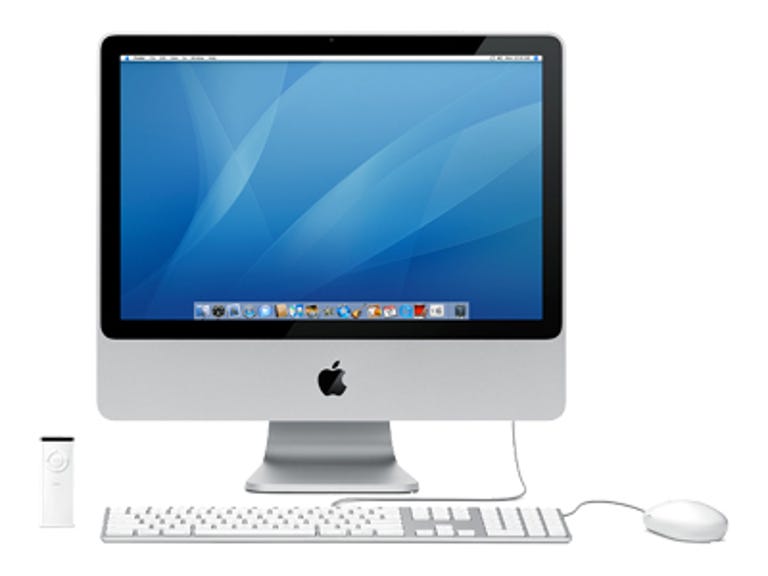 Why You Can Trust CNET
Why You Can Trust CNET Apple iMac (4th Gen.) review: Apple iMac (4th Gen.)
Apple iMac (4th Gen.)
The 24-inch iMac's striking design and impressive performance compare favorably to its smaller 20-inch sibling. In addition to a larger screen size, the 24-inch model offers higher-end configuration options and, of course, a higher price tag. The 24-inch iMac comes in two standard configurations. The $1,799 system includes a 2.4GHz Core 2 Duo processor, 1GB of memory, and a 320GB hard drive; the higher-end configuration costs $2,299 and comes with a dual-core 2.8GHz Core 2 Extreme CPU, 2GB of RAM, and a 500GB hard drive.
The Good
The Bad
The Bottom Line
We tested the fastest-available, 2.8GHz version with the optional 750GB hard disk, which added another $150 to the price tag, bringing the total cost of our configuration to $2,449. For more on the design, features, and service and support of the fourth-generation iMac, check out our in-depth review of the 20-inch, 2.4GHz iMac.
When we tested the 20-inch, 2.4GHz iMac last month, we came away impressed by its application performance, with it more than holding its own against competing Windows-based, mainstream desktops. The same can easily be said for the 24-inch, 2.8GHz iMac. With its faster processor, the 24-inch, 2.8GHz iMac is expectedly faster than the 20-inch, 2.4GHz iMac on all of our application benchmarks--as well as many similarly priced Windows machines. Of particular note is the 2.8GHz iMac's performance on our multimedia multitasking test--perhaps our most punishing benchmark. The test performs simultaneous video and audio encoding, which typically taxes the resources of most systems. The 24-inch, 2.8GHz iMac's best-of-class performance on this test is an excellent indicator of the iMac's potential for tackling processor-intensive applications and juggling the demands of multiple applications concurrently vying for system resources.
The only performance area in which the iMac disappoints is with its 3D gaming proficiency--or lack of it. We were surprised to see the 24-inch turn in even lower scores on our Quake 4 test than we saw with the 20-inch model. This disparity is still a bit of a mystery for us as both systems use the same graphics engine. Regardless, while the bigger model nets you a larger screen, a faster processor, more memory, and bigger hard drive, there are no options for speedier graphics.
The ultimate question is whether the 24-inch, 2.8GHz iMac is worth spending $800 more than the 20-inch, 2.4GHz version for a 16 percent improvement in performance and 30 percent more screen real estate. Serious multitaskers and some prosumers can definitely gain additional screen area to support more open applications on the desktop, and the modest performance bump can make a difference during longer video or audio renders. Perhaps the ideal user is someone who needs as much processing power as possible from a Mac, but can't justify the much costlier Mac Pro.
(Shorter bars indicate better performance)
(Shorter bars indicate better performance)
(Shorter bars indicate better performance)
(Longer bars indicate better performance)
| Rendering multiple CPUs | Rendering a single CPU |
(Longer bars indicate better performance)
| 1,024x768 (4x AA, 8x AF) |
Find out more about how we test desktop systems.
System configurations:
Apple iMac (20-inch, 2.4GHz)
Apple OS X; 2.4GHz Intel Core 2 Duo T7700; 2GB 800MHz DDR2 SDRAM; 256MB ATI Radeon HD 2600 Pro graphics chip; 320GB 7,200 rpm hard drive;
Apple iMac (24-inch, 2.8GHz) Apple OS X 10.4.10; 2.4GHz Intel Core 2 Extreme X7900; 2GB 667MHz DDR2 SDRAM; 256MB ATI Radeon HD 2600 Pro graphics chip; 750GB 7,200rpm hard drive
Apple Mac Pro Apple OS X 10.4.10; 2x2.66GHz Xeon X5355 (note that this is not a production configuration); 2GB 667MHz DDR2 FB-DIMM; 5126MB ATI X1900 graphics card; 500GB 7,200rpm hard drive
Dell Inspiron 531
Windows Vista Home Premium; 2.6GHz AMD Athlon 64 X2 5000+; 2GB 667MHz DDR2 SDRAM; 256MB Nvidia GeForce 8600 GT graphics card; 250GB 7,200rpm Western Digital hard drive
Gateway DX430X
Windows Vista Home Premium; 2.13GHz Intel Core 2 Duo E6420; 2GB 667MHz DDR2 SDRAM; 320MB Nvidia GeForce 8800 GTS graphics card; 500GB 7,200 rpm Seagate hard drive
HP Pavilion Media Center TV m8120n
Windows Vista Home Premium; 2.4GHz Intel Core 2 Quad Q6600; 3GB 1,066MHz DDR2 SDRAM; 128MB Nvidia GeForce 7350 LE graphics card; two 320GB 7,200rpm Hitachi hard drives
Sony VAIO TP1 Living Room PC
Windows Vista Home Premium; 1.83GHz Intel Core 2 Duo T5600; 2GB 667MHz DDR2 SDRAM; 32MB (shared) Intel 945GM integrated graphics chip; 300GB 7,200rpm Seagate hard drive
Velocity Micro ProMagix E2035
Windows Vista Home Premium; 2.4GHz Intel Core 2 Duo E6600; 2GB 667MHz DDR2 SDRAM; 512MB Nvidia GeForce 8600 GT graphics card; 320GB 7,200 rpm Hitachi hard drive
Velocity Micro Vector GX Campus Edition
Windows Vista Home Premium; 1.86Ghz Intel Core 2 Duo 6320; 2GB 800MHz DDR2 SDRAM; 256MB GeForce 8600 GT graphics card; 320GB 7,200 rpm Hitachi hard drive
